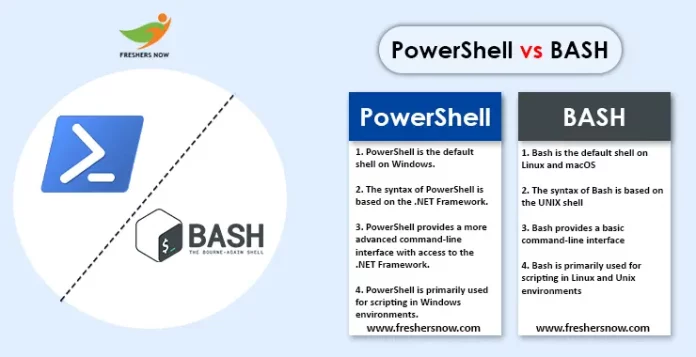
Difference Between Powershell and Bash: PowerShell and Bash are two of the most widely used command-line interfaces for scripting and automation. While both of them share some similarities, they have a number of differences that set them apart. In this article, we will explore the top 50 differences between PowerShell and Bash, highlighting the key features and functionalities of each.
PowerShell vs Bash
Whether you are a beginner or an experienced developer, understanding the differences between PowerShell and Bash can help you choose the right tool for your specific needs. So, let’s dive in and explore the key differences between PowerShell and Bash, and help you decide which one is the best fit for your projects.
Bash Vs PowerShell | Comparision of Bash and PowerShell
This section will provide you with an understanding of the definitions of PowerShell and Bash.
What is Bash?
Bash is a Unix shell and command language that is commonly used in Linux and Unix-based operating systems. It is the default shell in most Linux distributions and provides users with a powerful and flexible command-line interface for interacting with the operating system. Bash allows users to execute commands, navigate directories, manage files and directories, and perform various administrative tasks. It also supports scripting, allowing users to write and execute scripts that can automate complex tasks and perform system administration functions. Due to its widespread use in the Linux community, Bash has become an essential tool for developers and system administrators working in Unix and Linux-based environments.
What is PowerShell?
PowerShell is a command-line shell and scripting language developed by Microsoft for managing and automating tasks in the Windows operating system. It provides users with a powerful and flexible way to automate system administration tasks, including configuration management, remote management, and scripting of administrative tasks. PowerShell uses a combination of cmdlets, scripts, and pipelines to perform complex operations and is designed to be easy to learn and use for both IT professionals and developers. With its advanced functionality and support for remote management, PowerShell has become an essential tool for managing Windows-based systems in both small and large-scale environments.
Top 50 Differences Between PowerShell and Bash
PowerShell and Bash are popular command-line interfaces for scripting and automation, but they differ in several ways. Here are the Top 50 Differences Between PowerShell and Bash.
| Sl. No. | PowerShell | Bash |
|---|---|---|
| 1. | Developed by Microsoft | Developed by GNU Project |
| 2. | Built on .NET Framework | Built on Unix shell |
| 3. | Object-oriented scripting language | Text-based scripting language |
| 4. | Uses .ps1 file extension for scripts | Uses .sh file extension for scripts |
| 5. | Supports both Windows and Linux | Primarily used on Unix-based systems |
| 6. | Case-insensitive by default | Case-sensitive by default |
| 7. | Uses cmdlets to perform tasks | Uses commands and utilities |
| 8. | Can access .NET framework libraries | Cannot access .NET framework libraries |
| 9. | Supports pipelining of objects | Supports pipelining of text |
| 10. | Requires explicit permission to execute scripts | Does not require explicit permission to execute scripts |
| 11. | Can execute commands remotely | Can execute commands remotely through SSH |
| 12. | Has a graphical user interface (GUI) | Primarily used through a command-line interface |
| 13. | Can access and modify the Windows registry | Cannot access the Windows registry |
| 14. | Supports advanced functions and modules | Does not have advanced functions and modules |
| 15. | Uses verb-noun syntax for cmdlets | Uses noun-verb syntax for commands |
| 16. | Supports both batch and interactive mode | Supports both batch and interactive mode |
| 17. | Supports event-driven scripting | Does not support event-driven scripting |
| 18. | Includes a built-in help system | Includes a built-in help system |
| 19. | Supports dynamic parameter binding | Does not support dynamic parameter binding |
| 20. | Supports parallel processing | Does not support parallel processing |
| 21. | Supports multiple pipelines | Supports multiple pipelines |
| 22. | Supports output redirection | Supports output redirection |
| 23. | Supports command substitution | Supports command substitution |
| 24. | Supports process substitution | Does not support process substitution |
| 25. | Supports script debugging | Supports script debugging |
| 26. | Supports remote debugging | Does not support remote debugging |
| 27. | Supports transactions | Does not support transactions |
| 28. | Supports background jobs | Supports background jobs |
| 29. | Supports script signing | Does not support script signing |
| 30. | Supports XML manipulation | Does not support XML manipulation |
| 31. | Supports JSON manipulation | Does not support JSON manipulation |
| 32. | Supports .NET object serialization | Does not support .NET object serialization |
| 33. | Supports WMI (Windows Management Instrumentation) | Does not support WMI |
| 34. | Supports Active Directory management | Does not support Active Directory management |
| 35. | Supports SQL Server management | Does not support SQL Server management |
| 36. | Supports PowerShell ISE (Integrated Scripting Environment) | Does not support PowerShell ISE |
| 37. | Supports PowerShell Core (cross-platform version) | Does not support PowerShell Core |
| 38. | Supports tab completion | Supports tab completion |
| 39. | Supports aliasing of cmdlets | Supports aliasing of commands |
| 40. | Supports advanced error handling | Does not support advanced error handling |
| 41. | Can be used as a scripting language for .NET applications | Cannot be used as a scripting language for .NET applications |
| 42. | Supports .NET interop | Does not support .NET interop |
| 43. | Supports automatic variables | Does not support automatic variables |
| 44. | Supports modules with versioning | Does not support modules with versioning |
| 45. | Supports script profiles | Does not support script profiles |
| 46. | Supports binary cmdlets | Does not support binary cmdlets |
| 47. | Supports remote session configuration | Does not support remote session configuration |
| 48. | Supports background runspaces | Does not support background runspaces |
| 49. | Supports advanced debugging features | Does not support advanced debugging features |
| 50. | Supports secure credential storage | Does not support secure credential storage |
Conclusion: Difference Between Powershell and Bash
PowerShell and Bash are two powerful scripting languages with their own strengths and weaknesses. PowerShell is a more modern, object-oriented language built on the .NET framework, while Bash is a text-based language that is primarily used on Unix-based systems. PowerShell supports advanced features such as pipelining of objects, dynamic parameter binding, and remote execution of commands, while Bash is known for its simplicity and versatility. Overall, both PowerShell and Bash are valuable tools for automating tasks and managing systems, and understanding the differences between the two can help you choose the right tool for your needs. Whether you are working on a Windows or Unix-based system, there is a scripting language that can help you get the job done efficiently and effectively.
Hoping that the details presented on the Top 50 Differences Between PowerShell and Bash have been informative. To stay informed with the latest information, please visit freshersnow.com.



